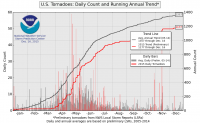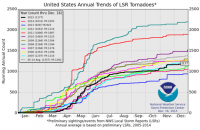Pete Kustra
EF0
I've heard that this year's shortage of tornadoes and severe thunderstorms was caused mostly by a trough which caused below seasonal temperatures in the east and above-seasonal temperatures in the west. Was it this specific arrangement of air temperatures that suppressed the development of severe storms, or do cooler winter/early spring temperatures generally not favor severe weather later in the spring? If that's the case then can we expect more severe storms in the Midwest and less in the south in 2016 if the forecasted temperature patterns hold?
Once again forgive my ignorance; like I said, I'm pretty new to severe weather and there's not a lot of info online about connections between winter conditions and storms later in the spring.
Once again forgive my ignorance; like I said, I'm pretty new to severe weather and there's not a lot of info online about connections between winter conditions and storms later in the spring.


